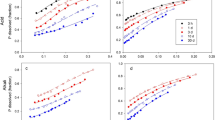Abstract
The liming potential of phosphate rock was evaluated with theoreticalcalculations and quantified by laboratory titration and soil incubation. Threeanions present in the carbonate apatite structure of phosphate rock that canconsume protons and cause an increase in pH when dissolved from apatite arePO4 3−, CO3 2−, andF−. The pKa for HF is so low that F− has verylittle effect on increasing pH. The pKa for 2 protons onH2PO4 − and H2CO3are sufficiently high enough to cause an increase in pH withPO4 3− and CO3 2−releasedinto solution if the pH range is between 4 and 6. Because of the greater molarquantity of PO4 3− compared toCO3 2−, PO4 3− exerts agreater affect on the liming potential of P rock. For a variety of phosphaterocks with a axes ranging from 9.322 to 9.374 Å in the carbonate apatitestructure, the theoretical % calcium carbonate equivalence (CCE) rangesfrom 59.5 to 62%. With the presence of gangue carbonate minerals from2.5to 10% on a weight basis in the phosphate rocks, the theoretical%CCE ranges from 59.5 to 63.1%. Use of AOAC method 955.01 forquantifying the %CCE of North Carolina phosphate rock (NCPR) and Idahophosphate rock (IDPR) resulted in %CCE ranging from 39.9 to 53.7%which were less than the theoretical values. The lower values measured in theAOAC method was presumed to be due to formation of CaHPO4 orCaHPO4·2H2O precipitates which would result inlessthan 2 protons neutralized per mole of PO4 3−released from carbonate apatite. The highly concentrated solution formed in themethod was considered not indicative of a soil solution and thus determined%CCE values would be suspect. A soil incubation study was conducted todetermine a more appropriate %CCE value in a soil environment usingCopper Basin, Tennessee soil with a soil pH of 4.2. Agricultural limestone,NCPR, IDPR, and a granulated IDPR were added to 100 g of soil atrates of 0.1, 0.3, 1, 3, and 10 g/kg soil, incubated for 105 daysat field moisture capacity, and analyzed for changes in soil pH and P. The%CCE of each phosphate rock addition was determined using limestone as astandard curve. The relationship between %CCE and % dissolved Pfollowed a quadratic model where%CCE = 8.47 + 0.0078(%dissolved P)2 (r2 = 0.84).At 0% dissolved P, the model predicted 8.47% CCE which wasprobably due to gangue carbonate minerals. The experimental model showedqualitative agreement with theory showing increased liming ability withincreased dissolved P from the P rock. However, the model showed lower%CCE than theoretical calculations when %P dissolved ranged from20 to 60%.
Similar content being viewed by others
References
Bolan H.S. and Hedley M.J. 1989. Dissolution of phosphate rock in soils. 1. Evaluation of extraction methods for the measurement of phosphate rock dissolution. Fert. Res. 19: 65–75.
Chien S.H. and Black C.A. 1976. Free energy of formation of carbonate apatites in some phosphate rocks. Soil Sci. Soc. Am. J. 40: 234–239.
Chien S.H. and Friesen D.K. 1992. Phosphate rock for direct application. In: Sikora F.J. (ed.), Future Directions for Agricultural Phosphorus Research. TVA Bulletin Y-224. Muscle Shoals, AL.
Hammond L.L., Chien S.H. and Mokwunye A.U. 1986. Agronomic value of unacidulated and partially acidulated phosphate rocks indigenous to the tropics. Adv. Agron. 40: 89–140.
He Z.L., Baligar V.C., Martens D.C., Ritchey K.D. and Kemper W.D. 1996. Factors affecting phosphate rock dissolution in acid soil amended with liming materials and cellulose. Soil Sci. Soc. Am. J. 60: 1596–1601.
Kane P.F. 1995. Agricultural liming materials. In: Cunniff P. (ed.), Official Methods of Analysis of AOAC International. AOAC International, Arlington, VA.
Lindsay W.L. 1979. Chemical Equilibria in Soils. John Wiley & Sons, New York.
Mackay A.D., Syers J.K., Tillman R.W. and Gregg P.E.H. 1986. A single model to describe the dissolution of phosphate rock in soils. Soil Sci. Soc. Am. J. 50: 291–296.
McClellan G.H. and Gremillion L.R. 1980. Evaluation of phosphatic raw materials. In: Khasawneh F.E. (ed.), The Role of Phosphorus in Agriculture. ASA, CSSA, SSSA, Madison, WI.
Mehlich A. 1953. Determinations of P, Ca, Mg, K, Na, and NH4, North Carolina Soil Testing Div. Mimeo. NC Dep. Agric., Raleigh.
Muncy J.A. 1986. A plan for cooperatively completing vegetation of Tennessee's Copper Basin by the year 2000, TVA/ONRED/LER-86/51. Technical Note B59.
Murphy J. and Riley J.P. 1962. A modified single solution method for the determination of phosphate in natural waters. Anal. Chim. Acta. 27: 31–36.
Sample E.C., Soper R.J. and Racz G.J. 1980. Reactions of phosphate fertilizers in soils. In: Khasawneh F.E. (ed.), The Role of Phosphorus in Agriculture. ASA, CSSA, SSSA, Madison, WI.
Sinclair A.G., Johnstone P.D., Smith L.C. and Risk W.I.I. 1993. Effect of reactive phosphate rock on the pH of soil under pasture. New Zealand J. Agr. Res. 36: 381–384.
Smith R.M. and Martell A.E. 1976. Critical stability constants. In: Inorganic Complexes Vol. 4. Plenum Press, New York.
Stumm W. and Morgan J.J. 1992. Aquatic chemistry. In: An Introduction Emphasizing Chemical Equilibria in Natural Waters. 2nd edn. John Wiley & Sons, New York, NY.
Author information
Authors and Affiliations
Rights and permissions
About this article
Cite this article
Sikora, F. Evaluating and quantifying the liming potential of phosphate rocks. Nutrient Cycling in Agroecosystems 63, 59–67 (2002). https://doi.org/10.1023/A:1020513722249
Issue Date:
DOI: https://doi.org/10.1023/A:1020513722249




